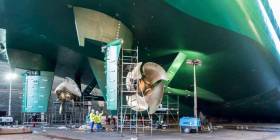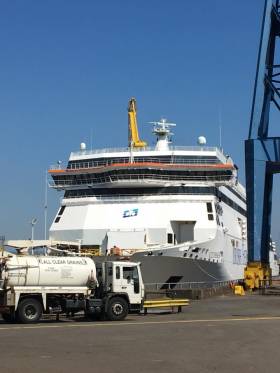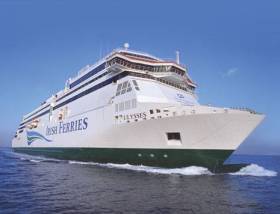Displaying items by tag: Ulysses
A Galway Port Scheme in Ulysses
In Ulysses Mr Deasy, headmaster of a private school, writes to the newspapers complaining that he knows of a cure for foot and mouth disease but nobody in authority will listen to him. Mr Deasy grandly compares his nebulous proposal to a major project from the 1850s which aimed to attract a growing transatlantic passenger traffic to Galway. Deasy calls to mind the “Liverpool ring which jockeyed the Galway harbour scheme” and describes himself as “surrounded by difficulties, by… intrigues, by… backstairs influence”.
The Galway Harbour scheme was no creation in a novelist's mind. Sixty years before Ulysses there was such a project and James Joyce was well informed about it. The project’s driving force was a dynamic priest named Fr. Peter Daly. Fr. Daly undertook various religious and welfare projects in Galway during the famine years and later involved himself in public life. He was a director of the Galway Gas Company and Chair of Galway Town Commissioners. As a board member of Midland & Great Western Railway Fr. Daly was instrumental in ensuring that the railway did not, as intended, end at Rahoon but reached Galway. He went on to ensure and oversee the construction of the then largest hotel in Ireland at Eyre Square.
Fr. Daly was also a member of Galway Harbour Commissioners and he sought to extend the new railway out to a proposed deep-water passenger facility at Furbo. He saw this as the final link in a chain which would allow ship-owners to offer a through-fare from Hamburg and points along the way across England and Ireland to New York. Such operators would have both a speed and a price advantage which would draw transatlantic traffic into Galway.
All his life Joyce was superstitious about dates and 16th June had special significance for him because it was on 16th June 1904 that he and Nora, his future wife, first walked out together in Dublin. That is why he places Ulysses in Dublin on 16th of June 1904 and why Bloomsday is celebrated around the world each year on 16th June. It is also why he was fascinated by the Galway Harbour scheme for which 16th June 1858 would prove portentous.
Later in Ulysses another voice speaks to the same subject when the putative Skin-the-Goat, keeper of the Cabman’s Shelter on Dublin’s Customs House Quay, laments the state of shipping in Ireland:
“ What he wanted to ascertain was why that ship ran bang against the only rock in Galway Bay when the Galway Harbour scheme was mooted…Ask her captain….how much palmoil the British Government gave him for that day’s work. Captain John Lever of the Lever line. -Am I right skipper? he queried of the sailor…”
 A 1904 cabman's shelter
A 1904 cabman's shelter
This is a reference the ship-owner John Orrell Lever who amassed profits chartering ships for the Crimean war and became interested in Galway for the development of a transatlantic passenger service to rival those of Liverpool and the ports of mainland Europe.
Several hundred Irish investors put up capital for his new company known as The Galway Line. The new service began in 1858 with Indian Empire which was the largest ship up to that time to enter the port of Galway and her arrival was widely anticipated.
On 16th June 1858, as two pilots were guiding her to port, Indian Empire grounded on the Margaretta Rock. Two and a half hours later, on a rising tide, the pilots managed to reverse her off and the steamship proceeded to anchorage with slight damage to her hull. She took on coal, cargo and passengers and on 19th June Indian Empire sailed for New York via Halifax.
However, on the day she had docked Captain Courteney, his crew and pilots were brought before an emergency meeting of Galway Harbour Commissioners. Rumours had begun to circulate about the grounding and a hostile crowd gathered. The pilots had to be protected by the police. Newspapers reported comments that the grounding was likely to turn out to be an attempt to wreck the ship in order to destroy the Galway harbour scheme. There was great discussion in public of plots, sabotage and especially “Liverpool gold at work”. Much was made of the fact that Lever had recruited the pilots in England. Reports were relayed outside Ireland as speculation lingered. Criminal charges were begun against the pilots. The sudden death of one of the pilots brought only more rumours and further press reports. Nowadays the position would be described as a publicity storm amplified by the absence of a media strategy and the credibility of the harbour project was diminished.
We know that Joyce was very taken with this tale and it is especially interesting that in Ulysses he leaves the final word on the subject to a sailor, Able seaman Murphy:
That worthy, picking up the scent of the fagend of the song or words, growled in wouldbe music, but with great vim, some kind of shanty…
- The biscuits was as hard as brass,
And the beef as salt as Lot’s wife’s’ arse.
O Johnny Lever!
Johnny Lever O!
James Joyce & Ulysses Links To Dublin Bay & Ringsend To Be Highlighted in Bloomsday Lecture In Ringsend Library
With Bloomsday on Thursday, June 16th, the ongoing Centenary of the publication of James Joyce's Ulysses will see even more local links to the great work and its author being highlighted and celebrated in many ways in several places.
Noted maritime historian and archivist Cormac Lowth is mining a rich and varied source in this presentation (open to all) which he will be giving in Ringsend Library on Thursday morning.
MV Ulysses Ferry Returns Following Dry Docking
The MV Ulysses, the leading Irish Ferries freight and tourism vessel on the Dublin to Holyhead route, returns to Dublin today following an extensive dry dock investment at Cammell Laird shipyard in Merseyside.
The four-week upgrade was undertaken to complete refurbishment and maintenance work and will see the Ulysses return to service looking like 'new', having had new propellers, new rudder components, a full refurbishment of her stern thruster and other underwater works. Investment didn’t stop there, with engine overhauls and Vehicle Deck painting programmes. Birkenhead based shipyard and engineering service company Cammell Laird was chosen for the MV Ulysses dry dock refurbishment due to their extensive expertise and a strong track record with this vessel.
Andrew Sheen, Irish Ferries Managing Director said “This is a significant investment in the Ulysses, which we know is a much-loved ship for both freight and tourism traffic. We are delighted to see her return to service to continue to provide the comfort and reliability that our customers expect from the Irish Ferries fleet”.
Ulysses Out of Service Again On Dublin-Holyhead Route
#FerryNews - Ulysses, flagship of Irish Ferries which was forced out of service for over a month during the peak season is once again not operating on the Holyhead route having docked in Dublin Port last night, writes Jehan Ashmore.
The company had cited a 'technical reason' though it is understood this incident it is not a repeat of the summer's problems with the starboard controllable pitch propeller which took place on 24th June. This led to the 50,938 gross tonnage flagship having to undergo major repairs in Harland & Wolff, Belfast. Otherwise the custom-built cruiseferry has had a strong reliability record since introduction in 2001.
Ulysses having completed a round trip to Holyhead, yesterday evening proceeded upriver to berth in Alexandra Basin. It would appear that the off service situation is short-term, given that the Ulysses is scheduled to return to service this Wednesday (1st November) on the 20:55 sailing to Holyhead. Check here for updates.
In the meantime while Ulysses remains in Alexandra Basin, this is also where earlier this month, the route's Holyhead newly introduced fast-ferry craft Dublin Swift had problems too. Work was carried out that enabled a return to the route just days before it ended a first 'seasonal' service previously operated by Jonathan Swift. The winter layover in the port of the larger and newer fast-craft is to end with resumption of sailings in Spring 2019.
Currently, taking place of Ulysses sailing roster is Isle of Inishmore, where Afloat noted a repositioning passage from Rosslare which saw an arrival yesterday morning to Dublin Port. The Isle of Inishmore is no stranger on the Dublin route having also been custom-built in 1997 to serve the north Wales route when ordered by the operator's parent company ICG.
Also operating on the Wales route but routinely is ropax Epsilon, however a third ferry was also in service until Sunday night, Oscar Wilde that provided additional sailings since earlier this month. The cruiseferry also served direct Dublin-Cherbourg crossings, however in the early hours of yesterday morning made a repositioning passage to Rosslare to take over the 'Inishmore' roster that began with a morning crossing to Pembroke.
On a related note to Ireland-France services, Afloat will have more to report on the much delayed €150m cruiseferry W.B. Yeats that was to have made a debut on the Dublin route last July followed by a transfer to Holyhead from September but only for the winter. During that time Epsilon would maintain the year-round operated route given no Rosslare based sailings.
Ulysses Returns To Irish Sea Service After Extended Repairs
#FerryNews - Ulysses has returned to service today (Thursday 26 July), having completed a sailing from Dublin Port to Holyhead this morning.
The Irish Ferries flagship left Belfast Dry Dock yesterday evening (Wednesday 25 July) after a month of extended repairs on a problem propeller shaft.
Epsilon, the ferry drafted to replace Ulysses on the current summer schedule, is expected to remain on standby should any further technical issues be encountered.
Afloat.ie's own Jehan Ashmore will be sailing on Ulysses later today.
#FerryNews - Technical issues for Irish Ferries Ulysses remain unresolved as they are more serious than originally anticipated, forcing the operator to cancel further sailings than expected during the peak season on the busy Dublin-Holyhead route.
Ulysses since late last month has been out of service due to problems with a propeller shaft that led to the largest ferry on the Irish Sea to receive repairs in Harland & Wolff, Belfast. The ferry was due to return to service last Wednesday, 4th July.
According to a statement issued today by Irish Continental Group (parent company of Irish Ferries), the cruiseferry reported technical issues of the starboard controllable pitch propeller on the (Sunday) 24th June. The investigation and repairs to the vessel were expected to take no longer than 5 days allowing the cruiseferry to resume service on the (Wednesday) 4th July. Service engineers have informed the operator, that the issue is more serious and the cruiseferry will be out of service for a further period of 1 to 2 weeks.
Irish Ferries added that despite their best efforts they were unable to find replacement tonnage in what is now the peak tourism season.
This is the first major technical problem to beset the Ulysses since introduction of the 50,938 gross tonnage cruiseferry in 2001. The vessel remains docked in Belfast Dry-Dock from where it entered on the 28th June. Afloat had previously tracked the cruiseferry make an overnight passage from Dublin Port on 26th June to Belfast Lough from where anchorage took place off Bangor before the dry dock could accommodate the 209m cruiseferry.
Irish Ferries said it would be contacting affected passengers and has adjusted the schedules of other vessels to minimise the disruption to customers as much as possible.
The operator said it will continue to run the schedule (Ex: Dublin – 08:05 & 20:55 and Ex: Holyhead – 02:40 & 14:10) using their alternate vessel Epsilon and will increase the number of Dublin Swift sailings with an additional round trip in the evening.
The disruption follows last month's announcement from ICG of another delay to newbuild delivery of cruiseferry W.B. Yeats. The cruiseferry which is similar in appearance to Ulysses but larger at around 55,000 tonnes is now set to enter service this autumn on the Dublin-Holyhead.
Originally, W.B. Yeats was to debut on the continental connection linking the capital and Cherbourg, France followed by a launch on the service to Wales in September.
#FerryNews - Operator Irish Ferries has said all sailings on the Ulysses vessel which serves the Dublin to Holyhead route have been cancelled for the next week.
As the The Irish Times reports, the ferry operator said the ship has been taken out of service due to a “technical issue” and to allow repairs be completed.
A spokeswoman for Irish Ferries said there is a problem with a propeller shaft necessitating the ship going to dry dock for a number of days and it is expected the Ulysses will return to normal service by the middle of next week.
In a statement (for updates click here) the company said all passengers affected are currently being advised and will be accommodated on an alternative ship or sailing.
For more on this story, click here.
Afloat adds the flagship departed Dublin Port this evening and is bound for Harland & Wolff, Belfast to undergo repairs.
#FerryNews - Ulysses, Irish Ferries cruiseferry on the Dublin-Holyhead route has sailings cancelled today (2 May) and up to Friday (4 May).
According to the operator's website this is due to technical reasons. All of the cruiseferry's operated sailings in both directions on the Ireland-Wales route are cancelled.
Passengers instead can be accommodated on the route's fastferry, HSC Dublin Swift and the ropax ferry Epsilon.
For updated sailing information click the link here and also for contact details.
The 50,938 gross registered tonnes flagship Ulysses is the largest ro-ro ferry operating on the Irish Sea. Since introduction in 2001, the cruiseferry has held a strong reliable track record of service maintaining the core short-sea route.
The cruiseferry is no longer docked at Dublin Ferryport Terminal 1 having proceeded upriver to berth in Alexandra Basin.
Flagship Ferry for Falmouth Homeport of the Wavewalker
#FlagshipRefit - The Iargest ferry on the Irish Sea the 50,938 tonnes Ulysses completed a Dublin-Holyhead crossing before departing Anglesey in the early hours of yesterday morning bound for an annual refit in Falmouth, writes Jehan Ashmore.
The flagship of Irish Ferries made what is understood to have been a 20 hour passage including the Celtic Sea before entering a drydock at A&P Falmouth last night in Cornwall.
The Finnish built flagship dating from 2001 was under the Irish flag, however for the past decade the 209 metre long vessel transferred to the Cypriot flag. She is to undergo a routine maintenance prior to beginning her 15th year in service.
Ulysses can carry 1,875 passengers, 1,372 cars and 300 trucks and is the fifth largest ferry in tonnage terms operating in UK waters. All these large ferries operate on North Sea routes to the Netherlands.
Taking Ulysses place on the Dublin route is Isle of Inishmore which repositioned from Rosslare-Pembroke duties and which in turn are been covered by Oscar Wilde. The Rosslare-based French seasonal services cruiseferry having completed Christmas sailings to boost capacity on the Holyhead service.
At the Cornish shiprepairer, conversion and maintenance facility is also the landing ship dock RFA Lyme Bay (L3007), coastal products tanker Whit Navigator and Wavewalker 1.
The latter craft based in Falmouth, is Fugro Seacore’s award-winning eight legged ‘walking’ jack-up rig that carried out maintenance work last year at the Arklow Arklow Bank Offshore Windfarm.
Irish Ferries Fleet Start Dry-Docking Schedule
#FERRY NEWS- This morning Irish Ferries Dublin-Holyhead route cruiseferry Ulysses departed for Birkenhead, on the Mersey, for annual maintenance at the Cammell Laird dry-docks facility, writes Jehan Ashmore.
In place of Ulysses, the Isle of Inishmore has taken up her sailing roster, as previously reported on Afloat.ie, the ro-pax ferry had last night completed her own additional sailings to cope with increased demand over the festive season.
Isle of Inishmore which normally operates the Rosslare-Pembroke Dock route, will too be dry-docked for 15 days at the same facility, releasing Ulysses which is expected to return to service on 14 January, with the 08.50hrs sailing to Holyhead.
When the 'Inishmore' is off service, she will be joined by the central-corridor route's fast-craft Jonathan Swift, albeit in a separate dock, remaining there until 2 February.
Once work on Isle of Inishmore is completed, she is planned to vacate the dock on 30 January, which in turn will allow cruiseferry Oscar-Wilde to enter the next day, for her period of routine maintenance.
This will allow Isle of Inishmore to return to the Rosslare-Pembroke Dock route, where the Oscar Wilde is currently operating. The French routes ferry Oscar Wilde will finally return to launch the Cherbourg route on 27 February, followed by high-season sailings to Roscoff beginning in May.





























































